about Daiwa Stock Indices(DSI)
Daiwa Stock Indices(DSI) is the performance index for Japanese stocks developed by
Daiwa Securities Co. Ltd. and Daiwa Institute of Research, Ltd.
DSI consists of DSI-1 and DSI-2.
1.DSI Categories
Daiwa Stock Indices(DSI) include DSI-1 and DSI-2. Both DSI-1 and DSI-2 have the same categories as below.
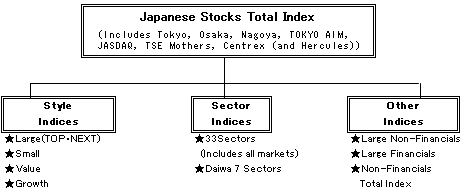 Indices Categories
Indices Categories
2.Outline of DSI Style Indices
- DSI are derived by weighting total returns of composing stocks by their market capitalization; DSI-1 are based on free-float shares, while DSI-2 are based on all listed shares.
- The universe includes all securities listed on Tokyo and Nagoya Stock Exchanges, Osaka Securities Exchange (until 12 July 2013), TOKYO PRO Market, JASDAQ (from the end of December 1989), TSE Mothers (from the end of December 1999), Centrex, and Hercules (from the end of December 2000 to 11 October 2010).
- Four major categories
- Large and Small
- Value and Growth
Large is subdivided into TOP and NEXT
- Starting date
- the end of December, 1983
- for Total, Large, and Small Indices of DSI-2: the end of December, 1979
- Value and Growth sectors have been decided using consolidated accounting data since the end of June, 1989
- Rebalanced twice a year at the end of June and December
- Indices including only securities listed on Tokyo Prime Market* are also provided. (*Tokyo Stock Exchange(TSE) 1st Section until 1 April 2022 )
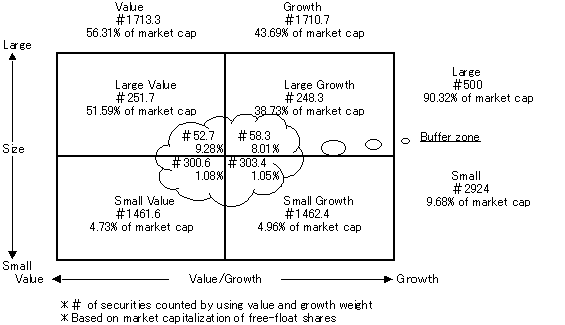 Composition of DSI-1 as of the end of the of December, 2000
Composition of DSI-1 as of the end of the of December, 2000
3.Size Classification
3-1.Size Classification
- Market capitalization is used for Size criteria(DSI-1: Market capitalization is without minority shareholders; free-float ratios weighted, DSI-2:Market capitalization of listed shares)
- Two major Size categories are Large and Small. Large is subdivided into TOP and NEXT
- Component stocks are decided by the ranking of market capitalization
-
Large
:the largest 500 stocks in terms of market capitalization
-
Small
:all other stocks
-
TOP
:the largest 100 stocks
-
NEXT
:remaining 400 stocks in Large
3-2.Market Capitalization
- We provide, under the name of DSI, two types of indices. Component stocks are weighted by different types of market capitalizations. As for DSI-1, we use only free-float shares (1), while we use all listed common shares (2) as for DSI-2.
- (1)=(# of shares outstanding * Free-Float ratio) * price
- (2)=(# of shares outstanding - preferred,deffered,governmentholding) * price
- Free-Float ratio = 1 - (# of minority shares / # of shares outstanding)
- In DSI-1, we use minority shares of TOYO KEIZAI in order to prepare Free-Float ratios of our own name. We set Free-Float ratios to be 0.2 without minority shares in case of new issue, no data and so on.
4.Value and Growth - Definition
4-1.Calculation of Composite score
- Value-Growth score
- Value-Growth Score (VGS) is a composite of Value-Growth factor
- VGS is a composite of the following 4 factors
-
A.
Actual Book to Market Capitalization (Value)
-
B.
Actual Earnings to Market Capitalization (Value)
-
C.
Estimated Return on Equity (Growth)
-
D.
Estimated Growth Rate (Growth):the average ranking of estimated sales growth and estimated earnings growth


- Composite of 4 factors
- Ranking(from the smallest) of 4 factors composes Value-Growth Score (VGS)
・VGS= ranking A+ ranking B- ranking C-ranking D
- Ranking(from the smallest) of 4 factors composes Value-Growth Score (VGS)
4-2.Consolidated and Estimated data
- Financial data
- In calculating Value-Growth Score(VGS), consolidated data have been used, when available, since the end of June, 1989.
(From the term ending in March, 1989, disclosure of consolidated financial statements became mandatory.)
- In calculating Value-Growth Score(VGS), consolidated data have been used, when available, since the end of June, 1989.
- Source of Estimated data
- Estimated data are from corporate reports and TOYO KEIZAI, and the most current data available at any given time are used.
- Definition of Estimated data
- In calculating estimated return on equity and estimated growth rates, average estimates for sales and earnings of the next 1st and 2nd settlement periods have been used since the rebalance at the end of June, 2000, because TOYO KEIZAI began to disclose estimated sales and earnings on a consolidation basis for the next two settlement periods.
4-3.Value - Growth Classification Method
- In consideration for relation between Size and Value-Growth
- Regression is applied to normalized Value-Growth Score (VGS) as a linear function of the logarithm of market capitalization in order to keep market value and the number of issues in balance.
- Normalized VGS is calculated from the following BLOM formula.

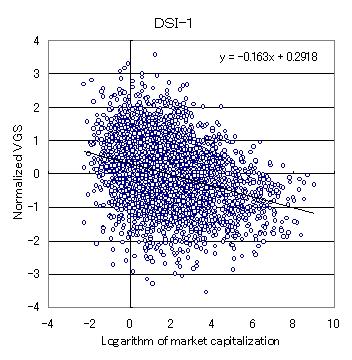
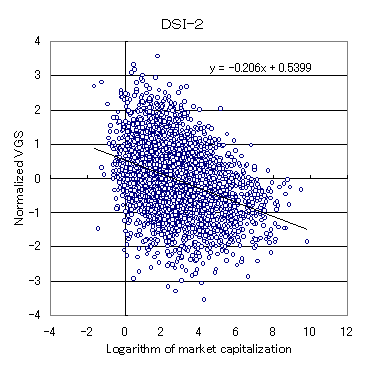 Scatter Diagram and Regression Line (as of the end of December,2000)
Scatter Diagram and Regression Line (as of the end of December,2000)
- Value-Growth Classification Score (VGCS)
- VGCS = Normalized VGS - estimate on the regression line
4-4.Value - Growth Weight
- Buffer zone and weight
- ±10% from the regression line is the buffer zone
- Every issue within the buffer zone has both value and growth weight
- Issues outside the buffer zone whose VGCS is sufficiently high are value and vice versa.
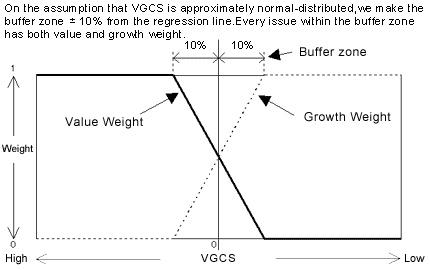 Value-Growth Buffer
Value-Growth Buffer
- Value-Growth Buffer in Style Categories
- Any stocks within the buffer zone have both Value and Growth weights.
- Value weight + Growth weight = 1
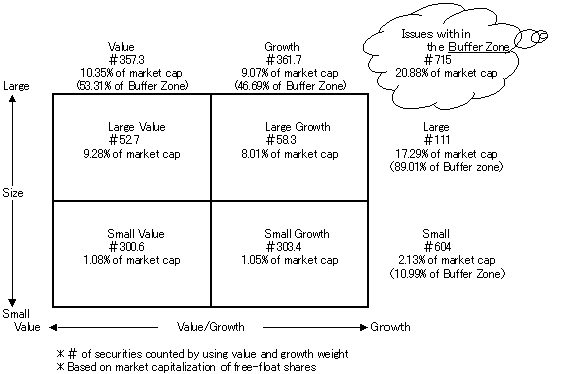 Composition of stocks within the buffer zone as for DSI-1 as of the end of December,2000
Composition of stocks within the buffer zone as for DSI-1 as of the end of December,2000
- Style Component of DSI-2
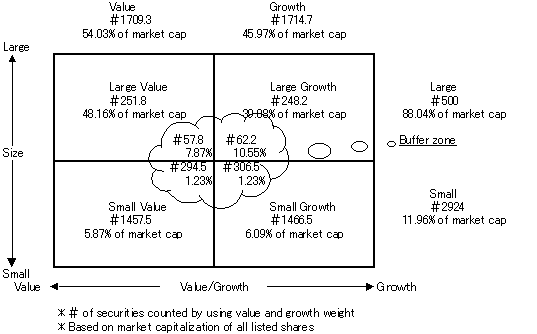 Composition of DSI-2 as of the end of December,2000
Composition of DSI-2 as of the end of December,2000
5.Varieties of DSI
| Overall | Value | Growth | ||
| Size | Total Index | Total Value Index | Total Growth Index | |
| Large Index | Large Value Index | Large Growth Index | ||
| Small Index | Small Value Index | Small Growth Index | ||
| Large | TOP Index | TOP Value Index | TOP Growth Index | |
| NEXT Index | NEXT Value Index | NEXT Growth Index | ||
33-Sectors, Daiwa 7-Sectors Indices
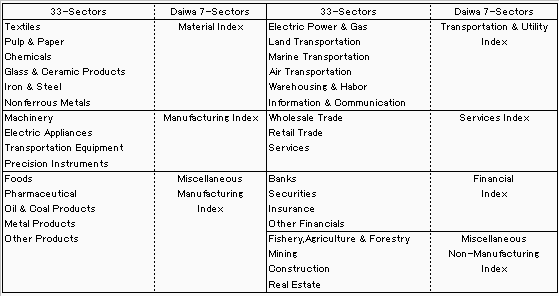
| Large Non-Financials Large Financials |
| Non-Financials Total Index |
6.Index Calculation, Detail
- Universe
- Common stocks listed on Tokyo and Nagoya Stock Exchanges, Osaka Securities Exchange (until 12 July 2013), TOKYO PRO Market, JASDAQ (from the end of December 1989), TSE Mothers (from the end of December 1999), Centrex, and Hercules (from the end of December 2000 to 11 October 2010)
- Bank of Japan and foreign stocks excluded
- Rebalancing
- Twice a year, at the ends of June and December
- Style weights of all stocks are decided on the 25th in the month of rebalance
- Stock Prices
- Closing price for each stock
- The Reference Base
- the end of December , 1983 = 100
- Calculation method
- Calculate total return (including dividends) on each stock
- Calculate index return by weighting each stock's return with its market capitalization of the previous day
- Calculate the index for current day = Index for previous day * (1+index return)
- New listing and de-listing
- Generally, newly listed stocks are added to universe when rebalancing
- If newly listed stocks are new companies made on a Stock-to-Stock, belonging to the large sector, they are added to the universe on the day of de-listing
- De-listed stocks are excluded from universe on the day of de-listing
7.Services
- Data Provided
- Indices
- Returns
- Market Capitalization Weights (data provided monthly)
- List of Stock names, Value-Growth Classification Score(VGCS) of each stock, Weight for each stock, etc
*On the two business days after June 25 and December 25, we will announce officially the VGCS and weight for each stock to be used on and after the 1st day of next month - Monthly Data: from the end of Dec, 1983(from the end of Dec, 1979 ; for Total, Large, and Small Indices of DSI-2)
- Daily Data: from the end of Jun, 1996
- Media
- Internet(https://www.dir.co.jp/InfoManage/datarsc-s.html)
- Information venders
QUICK(DIRJ100-108)
Bloomberg(DIDX)